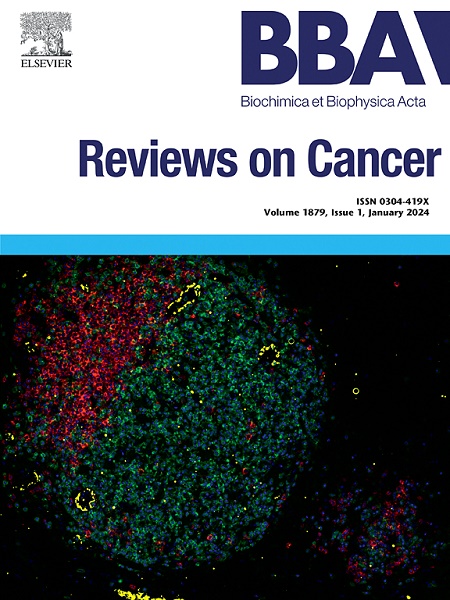高级别浆液性卵巢癌的生物标志物
IF 9.7
1区 医学
Q1 BIOCHEMISTRY & MOLECULAR BIOLOGY
Biochimica et biophysica acta. Reviews on cancer
Pub Date : 2024-11-01
DOI:10.1016/j.bbcan.2024.189224
引用次数: 0
摘要
高级别浆液性卵巢癌(HGSC)是卵巢癌中最常见的亚型。高分化浆液性卵巢癌患者通常是晚期患者,对化疗通常有耐药性,尽管最初对治疗有反应,但仍会复发,因此这种疾病的预后较差。有必要利用生物标志物来管理 HGSC 患者护理的各个方面。在这篇综述中,我们将讨论 HGSC 生物标志物的现状,重点是各种可用的免疫组化(IHC)和血液生物标志物,这些生物标志物在 HGSC 的诊断、预后和治疗方面的潜力已得到研究。其中包括各种常规临床 IHC 生物标记物,如 p53、WT1、角蛋白、PAX8、Ki67 和 p16,以及临床血液标记物和算法,如 CA125、HE4、ROMA、RMI、ROCA 等。我们还讨论了液体活检的各种成分以及一些新型 IHC 生物标记物和非常规血源性生物标记物,这些标记物已在各种卵巢癌研究中得到检验。我们还讨论了卵巢癌生物标记物研究的未来,并强调了该领域目前面临的一些挑战。本文章由计算机程序翻译,如有差异,请以英文原文为准。
Biomarkers in high grade serous ovarian cancer
High-grade serous ovarian cancer (HGSC) is the most common subtype of ovarian cancer. HGSC patients typically present with advanced disease, which is often resistant to chemotherapy and recurs despite initial responses to therapy, resulting in the poor prognosis associated with this disease. There is a need to utilise biomarkers to manage the various aspects of HGSC patient care. In this review we discuss the current state of biomarkers in HGSC, focusing on the various available immunohistochemical (IHC) and blood-based biomarkers, which have been examined for their diagnostic, prognostic and theranostic potential in HGSC. These include various routine clinical IHC biomarkers such as p53, WT1, keratins, PAX8, Ki67 and p16 and clinical blood-borne markers and algorithms such as CA125, HE4, ROMA, RMI, ROCA, and others. We also discuss various components of the liquid biopsy as well as a number of novel IHC biomarkers and non-routine blood-borne biomarkers, which have been examined in various ovarian cancer studies. We also discuss the future of ovarian cancer biomarker research and highlight some of the challenges currently facing the field.
求助全文
通过发布文献求助,成功后即可免费获取论文全文。
去求助
来源期刊

Biochimica et biophysica acta. Reviews on cancer
医学-生化与分子生物学
CiteScore
17.20
自引率
0.00%
发文量
138
审稿时长
33 days
期刊介绍:
Biochimica et Biophysica Acta (BBA) - Reviews on Cancer encompasses the entirety of cancer biology and biochemistry, emphasizing oncogenes and tumor suppressor genes, growth-related cell cycle control signaling, carcinogenesis mechanisms, cell transformation, immunologic control mechanisms, genetics of human (mammalian) cancer, control of cell proliferation, genetic and molecular control of organismic development, rational anti-tumor drug design. It publishes mini-reviews and full reviews.
 求助内容:
求助内容: 应助结果提醒方式:
应助结果提醒方式:


